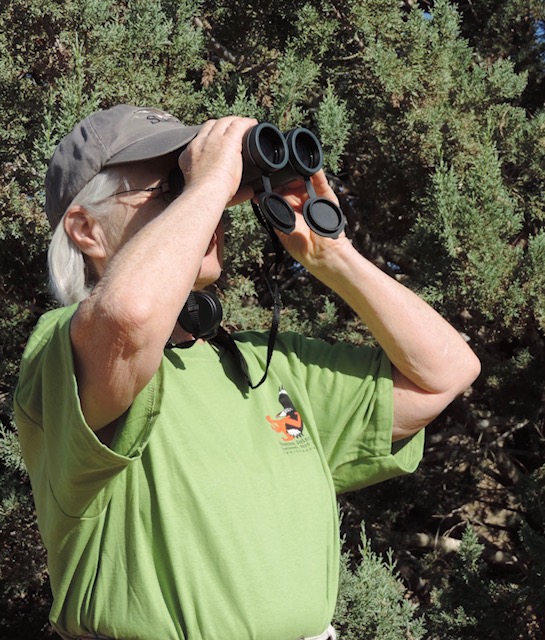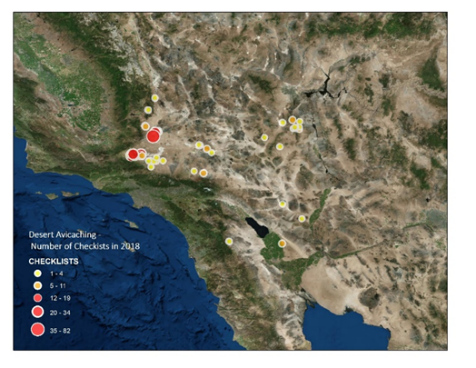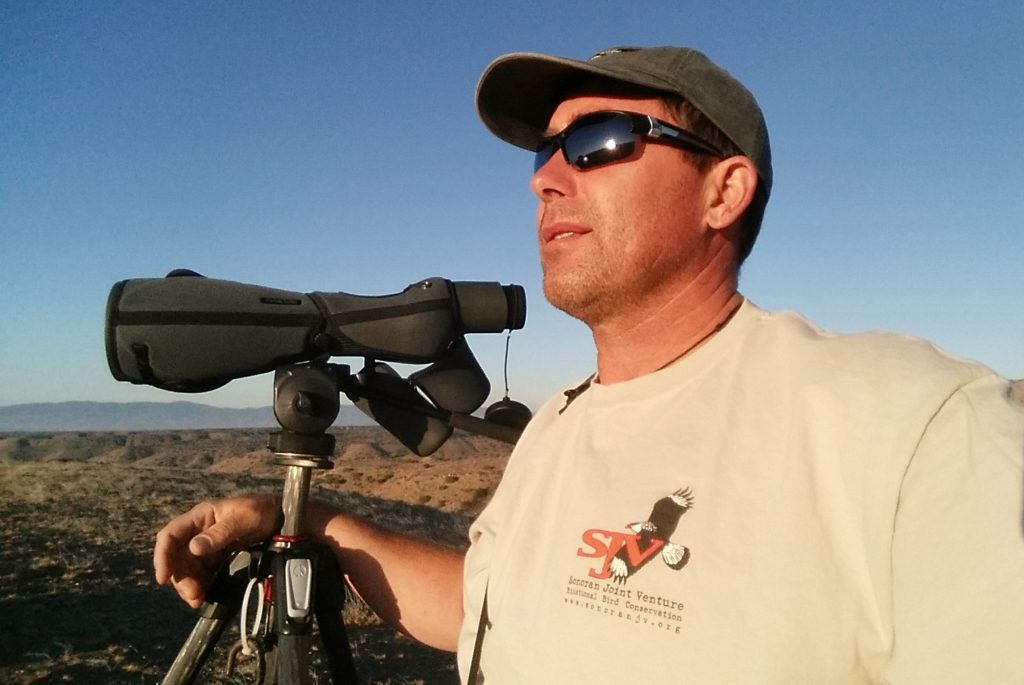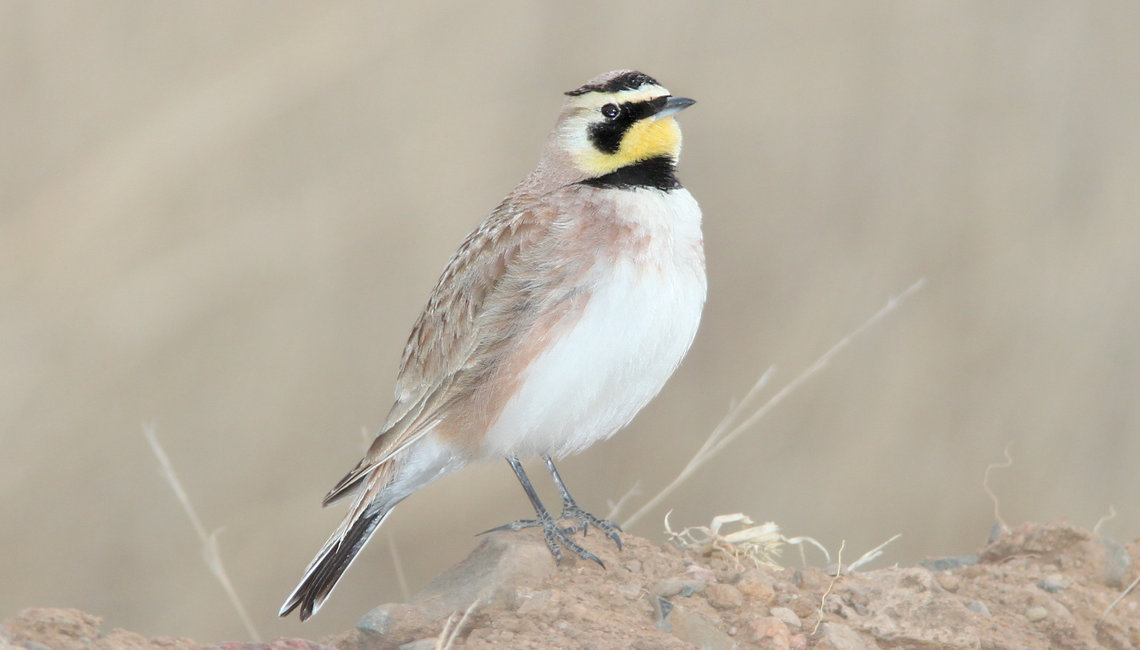By Emily Clark and Jennie Duberstein of the Sonoran Joint Venture, and Chris McCreedy, Research Associate, Point Blue Conservation Science
In February of 2018, we introduced you to our pilot season of Desert Avicaching. Designed to engage citizen science volunteers, Desert Avicaching sought to use the power of the people to help fill knowledge gaps and guide future management actions for the Colorado and Mohave Deserts. Our focus was to learn more about migrant bird’s use of desert habits, especially in relation to locations with solar development, as well as to hone in on a specific group of species, thrashers. So, how did we do?
First, a brief recap. Desert ecosystems like the Colorado and Mohave deserts of southern California are under threat, largely from the pressures of encroaching human development, water scarcity, and effects of climate change. Likewise, species including Bendire’s and LeConte’s Thrashers are among the fastest declining species in arid lands (read more about thrashers). Solar and wind energy farms dot the landscape, but little is known about how these facilities affect the local and migrating bird communities. With the exception of known “migrant traps,” desert habitats are persistently under-birded due to their remoteness, low population density, low road density, and harsh weather conditions.
During the fall 2015 SJV Science Working Group meeting, a breakout group discussed their concerns about desert species and habitats, including the need for more information. However, faced with limited personnel and resources, how were we going to learn more about these at risk areas?

An idea was workshopped that led our partners at Point Blue Conservation Science to submit a proposal to the SJV Awards Program (that was subsequently funded) to take Cornell Lab of Ornithology’s idea of Avicaching (check out our past article to learn more) and implement it in the SJV region. Building on eBird and the concept of geocaching, Avicaching helps collect information about birds in areas with little data by activating the eBirder community to go to specific locations (identified as eBird Hotspots) and upload checklists of birds from each “Avicache.”
Overall, the pilot season was a success, as well a great learning experience for the team. In total, 72 volunteers submitted 409 distinct eBird checklists from 53 Desert Avicaching locations during the winter and spring of 2018. These checklists encompassed nearly 350 total survey hours. That is comparable to one full-time biologist surveying five days a week at eight hours a day, for over 2 months! If you factor in travel and gasoline costs, we estimate our avicachers contributed over 500 hours of their time surveying and $2,000-$3,000 in travel mileage.
By analyzing the survey effort and location data, we were able to gather some important information about the avicachers that will help us in developing future projects. First, while we had a good number of participants, the same few people contributed the majority of ebird lists. Deemed our “core” observers, these avicachers consistently birded at avicaching locations several times per week, often-contributing checklists from multiple avicaching locations within one morning. Our “casual” observers were those who submitted less than five checklists over the entire study period. The core observers were generally recruited from our in-person visits to local conservation groups and Audubon chapters to talk about the project.

In the future, we know to focus our outreach efforts there in order to increase our data set. Despite trying to get people out to remote areas, locations with the highest visitation rates were near where volunteers lived. A large majority of submitted checklists were from Kern County, in a portion of the western Mojave Desert, which holds several solar facilities.
While we had some awesome swag donated, we learned from our volunteers that the prize drawings were an added bonus, but not the only incentive of playing. Our grand prizewinner, Kerry Ross, submitted a whopping 148 checklists and recorded 95 species. He expressed his concerns about solar fields going up at “alarming rates” across the west side of Antelope Valley in Kern and Los Angeles counties. He says of his efforts, “Of particular interest to me was to collect data that might be used in future studies to better understand the relationship between birds and the large solar fields that are being developed across the desert”.

Desert Avicaching’s data objectives focused on migrating birds and thrasher species. We found that the data quality from volunteers was high (submitted checklists were complete, and frequently included descriptions and photos). During the 2018 study period, observers identified 142 species, and 16,033 individual birds that were thought to be in active migration. Horned Lark, while not a breeder in the desert, was by far the most commonly observed species (over 6,300 were recorded). LeConte’s Thrashers were recorded on seven checklists, four of which were solar mitigation sites. These represent new records for the species at those locations. Bendire’s Thrashers were recorded on five checklists, and each sighting was taken at an established thrasher point. This information was provided to the Desert Thrasher Working Group, a cross-organizational team working on thrasher conservation and management.
We hope to continue using this data to inform management decisions for alternative energy projects. In addition, we are exploring potential funding opportunities to continue Desert Avicaching or implement new avicaching games across the region. Thank you to all of our participants and our sponsors (American Birding Association, Athlon Optics, BirdsEye Nature Apps, Point Blue Conservation Science, Wildwings Backyard Nature Store, and PhoneSkope).

